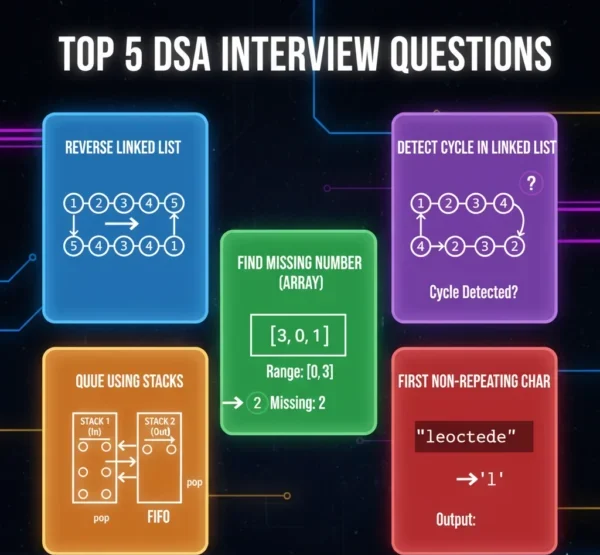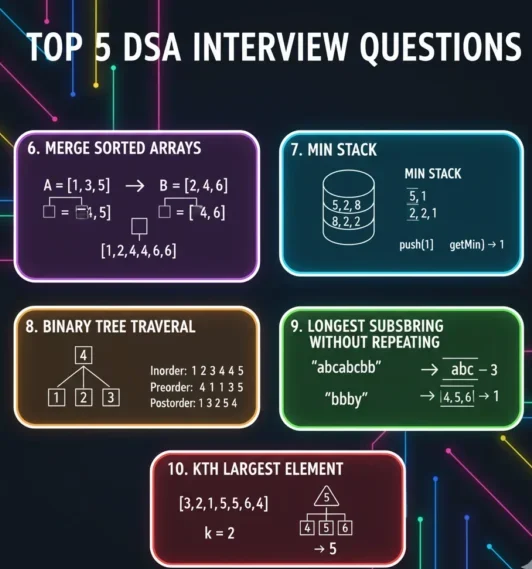Top Data Structure Algorithm Interview Questions with Examples

When you sit down for a coding interview, it doesn’t take long before the interviewer throws a question on data structures or algorithms your way. These data structure algorithm interview questions aren’t just about writing a few lines of code. They’re designed to see how well you understand the basics, how you approach solving problems, and whether you can come up with clean and efficient solutions under time pressure.
In this guide, I’ll walk you through some of the most commonly asked questions in interviews. Each one comes with a short explanation and a simple example in Python so that you can practice right away.
1. Reverse a Linked List In Data Structure Algorithm
Question: Given the head of a singly linked list, reverse it.
Why it matters: This checks if you really understand pointers and how linked lists work.
class Node:
def __init__(self, data):
self.data = data
self.next = None
def reverse_linked_list(head):
prev = None
current = head
while current:
nxt = current.next
current.next = prev
prev = current
current = nxt
return prev
2. Detect a Cycle in a Linked List
Question: How do you find if a linked list contains a cycle?
This is where Floyd’s Cycle Detection (Tortoise and Hare) comes in.
def has_cycle(head):
slow, fast = head, head
while fast and fast.next:
slow = slow.next
fast = fast.next.next
if slow == fast:
return True
return False
3. Find the Missing Number in an Array In Data Structure
Question: You have numbers from 1 to n, but one number is missing. Find it.def missing_number(nums):
n = len(nums) + 1
total = n * (n + 1) // 2
return total – sum(nums)
print(missing_number([1,2,4,5])) # Output: 3

4. Implement a Queue Using Stacks
Interviewers love to test if you can build one structure from another.
class QueueUsingStacks:
def __init__(self):
self.stack1 = []
self.stack2 = []
def enqueue(self, x):
self.stack1.append(x)
def dequeue(self):
if not self.stack2:
while self.stack1:
self.stack2.append(self.stack1.pop())
return self.stack2.pop() if self.stack2 else None
5. First Non-Repeating Character in a String
Question: Given a string, return the first non-repeating character.
from collections import Counter
def first_unique_char(s):
count = Counter(s)
for ch in s:
if count[ch] == 1:
return ch
return None
print(first_unique_char(“swiss”)) # Output: ‘w’
6. Merge Two Sorted Arrays
This shows whether you can handle sorted data efficiently.
def merge_sorted(arr1, arr2):
i = j = 0
merged = []
while i < len(arr1) and j < len(arr2):
if arr1[i] < arr2[j]:
merged.append(arr1[i])
i += 1
else:
merged.append(arr2[j])
j += 1
merged.extend(arr1[i:])
merged.extend(arr2[j:])
return merged
print(merge_sorted([1,3,5], [2,4,6]))
# Output: [1,2,3,4,5,6]

7. Min Stack
Question: Design a stack that supports push, pop, and also retrieving the minimum element in constant time.
class MinStack:
def __init__(self):
self.stack = []
self.min_stack = []
def push(self, x):
self.stack.append(x)
if not self.min_stack or x <= self.min_stack[-1]:
self.min_stack.append(x)
def pop(self):
if self.stack[-1] == self.min_stack[-1]:
self.min_stack.pop()
return self.stack.pop()
def get_min(self):
return self.min_stack[-1]
8. Binary Tree Traversal
One of the most basic tree problems.
class TreeNode:
def __init__(self, val=0, left=None, right=None):
self.val = val
self.left = left
self.right = right
def inorder(root):
if not root:
return []
return inorder(root.left) + [root.val] + inorder(root.right]
9. Longest Substring Without Repeating Characters
This problem checks your sliding window technique.
def longest_unique_substring(s):
seen = {}
start = max_len = 0
for i, ch in enumerate(s):
if ch in seen and seen[ch] >= start:
start = seen[ch] + 1
seen[ch] = i
max_len = max(max_len, i – start + 1)
return max_len
print(longest_unique_substring(“abcabcbb”)) # Output: 3
10. Kth Largest Element in an Array
Heap-based question that comes up a lot.
import heapq
def kth_largest(nums, k):
return heapq.nlargest(k, nums)[-1]
print(kth_largest([3,2,1,5,6,4], 2)) # Output: 5
Data Structure Algorithm Interview Final Thoughts
When you practice these data structure algorithm interview questions, don’t just think of them as exam prep. What really happens is that your brain starts training itself to look at problems differently. You’ll get used to breaking things into smaller steps, and after a while, spotting patterns feels natural. Memorizing code won’t help much—understanding the “why” behind it will. That’s the part interviewers actually notice. That’s what really sticks. Once you understand that, you’ll be able to tackle even the tricky variations interviewers like to throw in.
If you keep practicing problems on arrays, linked lists, stacks, queues, trees, and .heaps, you’ll slowly get more comfortable. Over time, that practice builds confidence, and you won’t feel stuck when an interviewer puts a tough question in front of you.
Explore how Artificial Intelligence and Machine Learning are transforming the tech world .

